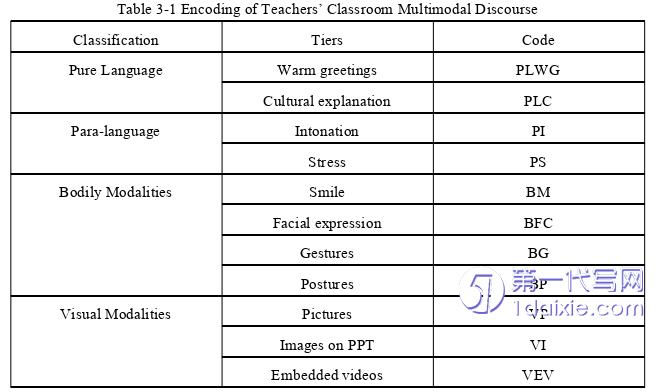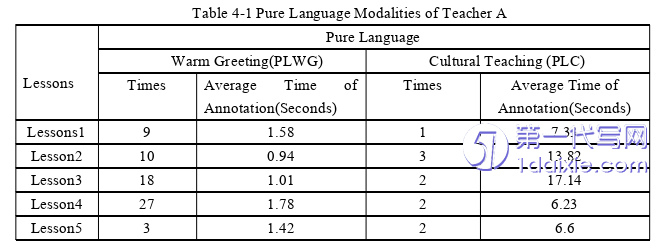本文是一篇英语论文,本文研究高中英语教师课堂多模态话语的差异对高中生英语学习动机的影响,选择了两种类型教师来进行研究,分别是经验型英语教师和新手型英语教师。
Chapter 1 Introduction
1.1 Research Background
Since the 20th century,with the use and spread of Multimodal Discourse,theresearch of it has become the national research emphasis.However,language teachingfocuses on the teaching and learning of language itself,mainly depending on the textmode in a textbook.At the same time,it doesn't emphasize the effects of other modesof language teaching.With the development of modern and mass-media technologiesand the application of multi-media and computers,Multimodal Discourse’scharacteristics are gradually becoming prominent in communication,such as images,sound,words,colors,space,and so on.In the present senior high school classroomteaching,some teachers explain and demonstrate for students to understand somecritical points.If they communicate with students just with language in a lesson,theywill need help to make students concentrate on their tasks.Therefore,in most cases,teachers will use nonverbal teaching methods;for example,they insert gestures or addsome emotional intonation when they read the text’s climax or illustrate somethingwith modes,radio,and music.Thereby,it helps students to feel teachers’flexible andlively performance in class,which students are attracted by teachers’behavior toimprove high school’s teaching quality.Many researchers think that teachers have tocommunicate with students in the classroom.Besides,communication is not only onlanguage but also on behavior,which is beneficial to expanding classroom teaching.In all of these,verbal and non-verbal modalities are crucial in the English learningprocess.We have to combine them well and achieve the classroom teaching effects.

1.2 Research Purpose
The MDA(Multimodal Discourse Analysis)in English classroom teaching ispopular in some Western countries,whereas the research on MDA in China needs tocatch up.At the same time,the application of MDA to English classroom teaching ishighlighted in universities in China,while the research in senior high schools is muchless.In addition,experienced and novice English teachers use various kinds of multimodal discourse in classroom to stimulate students’motivation.Furthermore,wealso want to learn about the mechanisms behind them.For another,with theinformation progress in economic globalization and social life,English,as a languagetool and media,plays an essential role in communication.At this time,English hasbeen a compulsory course for senior high school students,which is of the sameimportance as Chinese and math in classroom.However,the teaching effects areunsatisfactory and have not achieved desired effects.English teachers are moreclearly to foster students’sense of identity as the first goal.
Nevertheless,the key to success is cultivating students’interests.As everyoneknows,the process of English learning is intricate.It is affected by many aspects,such as intelligence,language aptitude,age,emotion,learning motivation,andlearning strategy,among which learning motivation plays a vital role.However,withthe increasing complexity and difficulty,students learn English with low motivationand even feel fear and disgust of English.Therefore,it is high time teachers tried toimprove students’learning motivation with their multimodal discourse in class.
Chapter 2 Literature Review
2.1 Definitions
2.1.1 Definitions of Multimodal Discourse
It is unavoidable to refer to modes and multimodality in multimodal discourse.Therefore,we will talk about the definitions of modes and definitions ofmultimodality first.
(1)Definitions of modes
First,Jewitt and Kress(2003)had put forward that modes were the standard andorderly set of resources for making meaning,including pictures,radios,gestures,postures,sounds,etc.
And then Zhu Yongsheng(2007)thought that modes refer to one of the threeelements(field of discourse,tenor of discourse,and mode of discourse)of context insystematic functional linguistics.It represented the communication channel,such asauditory and visual modes.In the same year,Gu Yueguo(2007)considered thatmodes were how human beings establish communication channels with the help ofoutside environments,such as the five senses,sight,hearing,taste,olfaction,andtactile.
All in all,modes were channels for human beings to communicate,includingverbal and non-verbal modes.
2.2 Theoretical Foundation
2.2.1 Theories of Motivation
Learning motivation was a mediating variable that stimulated and maintained learning behavior and made learners move towards the specific goal,involvinginterest,drive,and necessity.Learning motivation is one of the most dynamic factorsin language learning.Therefore,researchers have paid attention to learning motivationfor a long time.The theories of motivation could be divided into motivation theory ofbehaviorism,motivation theory of cognitive psychology,attribution theory,andhumanism and psychometrics of motivation theory.(Qin Xiaoqing,Wen Qiufang,2002;Zuobin,2002)
(1)Motivation theory of behaviorism
The theory was the psychological theory that was popular in America in the1920s,and Waston created it.(1913)The theory thought that management's qualitywas to stimulate learning behaviors.Under the guidance of the"stimulus-response"theory,the motivators’task was to choose a suitable stimulation,so it triggeredcorresponding behaviors.Besides,motivation of behaviorism believed motivation wasthe result reinforced by extrinsic force.The reinforcement rules were teachers’praiseand criticism to maintain learning motivation.However,behaviorism emphasizedreinforcing learning results through external control so that it will ignore students’internal force.Behaviorism mainly researched conditional responses like Pavlov’sclassical conditioning and Skinner’s operating conditioning.The new behaviorist,Skinner,put forwards the operating conditioning in which the compelling ways notonly rely on the stimulating variables but also we had to consider subjective factors.The new behaviorism theory emphasized that human behavior depended on theperception of stimulation and the result.If the behavior results benefited learners,thebehavior would repeatedly appear to reinforce the stimulation,whereas if the behaviorresults are harmful to learners,the behavior will disappear.Hence,it is necessary tofully use affirmation,praise,negation,and criticism in education,which can directlearners'behavior and lead them to the best state.
Chapter 3 Research Methodology .................. 21
3.1 Research Questions ............................ 21
3.2 Research Participants ........................ 21
Chapter 4 Results and Discussion ............................. 25
4.1 Characteristics of Teachers’ Multimodal Classroom Discourses .... 25
4.1.1 Characteristics of Experienced English Teachers’ Modalities ... 25
4.1.2 Characteristics of Novice English Teachers’ Modalities ........... 37
Chapter 5 Conclusion .............................. 74
5.1 Research Findings .................................. 74
5.2 Pedagogical Implications .................... 74
Chapter 4 Results and Discussion
4.1 Characteristics of Teachers’Multimodal ClassroomDiscourses
4.1.1 Characteristics of Experienced English Teachers’Modalities
According to Zhang Delu’s Multimodal Discourse Analysis,verbal modalitiesare divided into pure language and para-language.Hence,in the following chapter,wediscuss it based on Zhang’s MDA.
4.1.1.1 Pure Language Modalities of Experienced English Teachers
On the one hand,we selected five lessons for teacher A to annotate thecharacteristics of experienced English teachers.There are about thirty-five or fortyminutes in every observed lesson.Before the formal analysis of the thesis,weintroduce the research object,who is an experienced teacher at in Yuekou HighSchool,about 40 years old,and she has a title of educated veteran.Now,let’s talkabout the characteristics of teacher A in five lessons.

Chapter 5 Conclusion
5.1 Research Findings
In the first place,from the annotating of the classroom radios,we find that thereare few differences in the frequency of bodily modalities,visual modalities,andpara-language modalities used by experienced and novice English teachers,with theexperienced English teachers using stress,facial expressions,such as smiles,and PPTmodalities more.Moreover,the reasons causing the differences are teachers’teachingage,differences in teachers’multimodal discourse,and students’English preferences.
In the second place,from the questionnaire analysis,experienced Englishteachers use cultural backgrounds,smiles,and vivid pictures compared with noviceEnglish teachers,and students’extrinsic motivation is higher;when they use warmgreetings,thumb-ups,and cartoon videos,their intrinsic motivation is higher thanstudents in novice English teachers’classes.
In the third place,with the combination of videos and questionnaires,whetherexperienced or novice English teachers,their fluency,professional abilities,andstandard degree of English will influence students’extrinsic and intrinsic motivation.Moreover,students’English preferences and classroom reactions are beneficial fordeveloping teachers’multimodal discourse.
All in all,in the research,experienced English teachers influence students’learning motivation greatly no matter which kind of students they are teaching.However,students’learning motivation in novice English teachers’classes are notclear.Therefore,we have to come up with the ways to change the current situationbetween these two kinds of teachers.
reference(omitted)
